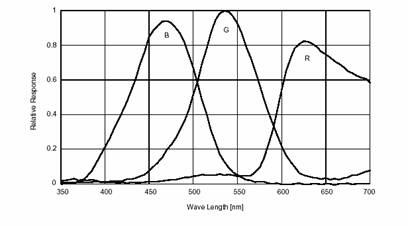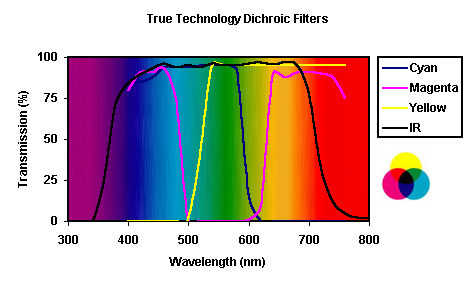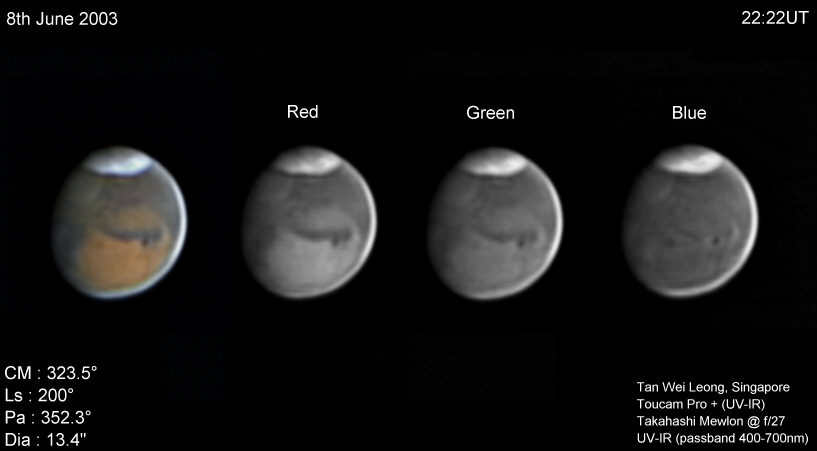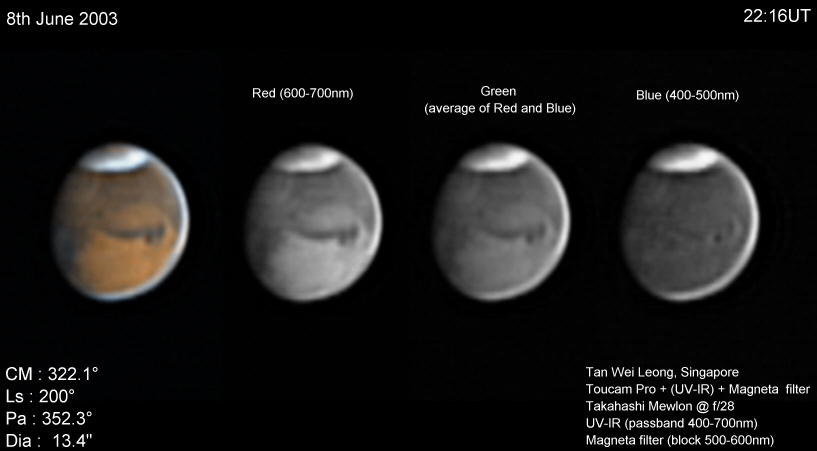


Spectral Sensitivity Characteristics of ICX098 CCD chip used in the Philips ToUcam.
As seen the spectral response of this CCD chip when used for producing individual R,G and B images by splitting from the master colour image will not produce data of the same quality as of the images had been obtained through the proper interference filters. Therefore with the toucam, without additional of external filters the result image is not suitable for studies of white clouds in mars.
The main problem lies in that, the response of the chip in Blue ends at 580nm and Red ends at 450nm (with a small response down to 350nm). An IR block is essential so as to prevent leakage of IR into the G and B frame but the problem still lies in the overall bandpass of the built in R, G and B.
|
Bandpass of the built-in R,G and B filters in the CCD chip of the toucam (with IR block, with IR cutoff at 700nm) |
|
| Red | 450 - 700nm |
| Green | 475 - 700nm |
| Blue | 375 - 580nm |
This in summary means that the Blue data is “polluted” into the green spectrum (B bandpass from 550nm to 580nm) which is why a little surface features remain visible, even when an IR block filter is used.) Also, the R data is slightly polluted by the Red bandpass down to 450nm.
In further reviewing the documentation, the way in which the CCD reads the data out also causes problems, as 2 x as much G signal is generated than R or B.
We present one possible solution to this problem below.

Spectral Sensitivity Characteristics of True Technology CMY filters
Looking at the spectral characteristics of the True-tech CMY filters, we can “pre-filter” the ICX098 CCD chip with the magenta filter (with cut off at 500-600nm and efficiency of more than 95%) including a suitable IR rejection filter. This will block the spectral region from 500nm to 600nm, and block both the G leak in Blue (500-580nm), and Blue/Green leak in Red (500-600nm). Signal lost in R and B would be kept to a minimum as the True-tech Magneta filter has bandpass of more than 95%.
The resulting bandpass for the B would be 375-500nm and 600-700nm (assuming we have a IR blocker that cuts off at 700nm). This compares very well with other RGB interference filters with IR blocker.
| Comparison of various commonly used Blue filters in Mars imaging | |
| Kodak Warren #47 | |
| CFW5C |
380-550nm |
| CFW8A | 390-520nm |
| B filter from Johnson UBVRI Photometric Filter set | 340-540nm |
| toucam + IRX | 375-580nm |
| toucam + baader UV-IR + True tech Magneta filter | 400-500nm |
Note: 1. Bandpass of filter is actual spectral response and not FWHM bandwidth
2. The baader UV-IR filter passes 400-700nm with 98% efficiency
Resulting signal lost with the baader UV-IR + True Tech magneta filter would be around 10-15% compared to the unfiltered toucam which we can compensate with an appropriate increase in gain. As the surface of mars is relatively bright the lost of 10-15% unwanted signal will not hurt the overall SNR too much.
To produce a RGB image for esthetic purpose we can construct a synthetic G by combining the R and B (with a ratio that can be easily worked out). As the G frame normally does not contain useful data for Mars and only the R and B are used for analysis, this will help to get better B and R frames using the ToUcam with very low extra cost and no modification, hopefully it will encourage more submitted images with useful data.
This solution will still allow an image to be captured with one AVI instead of resorting to individual external R and B interference filters which will require separate AVI files to be recorded for each of the filter.

Toucam Mars image with Baader UV-IR rejection filter

Toucam Mars image with Baader UV-IR rejection filter and True-Technology Magenta filter
Our final thoughts however, are perhaps while the ToUcam is a superb choice for producing high resolution colour imagery, perhaps the cooled CCD systems with proper filters still very much have the edge when one wishes to produce filtered imagery of Mars.
Regards,
Damian Peach
Tan Wei Leong
| Home
| About Me |
Guest Book |
Article
| News
| Links |
Email Me |
Best view at 1280x800 resolution
All images and Texts on these pages are Copyrighted.
It is strictly forbidden to use them without the written authorization of the author.
|
[an error occurred while processing this directive] |
Last revised: June 02, 2003. |